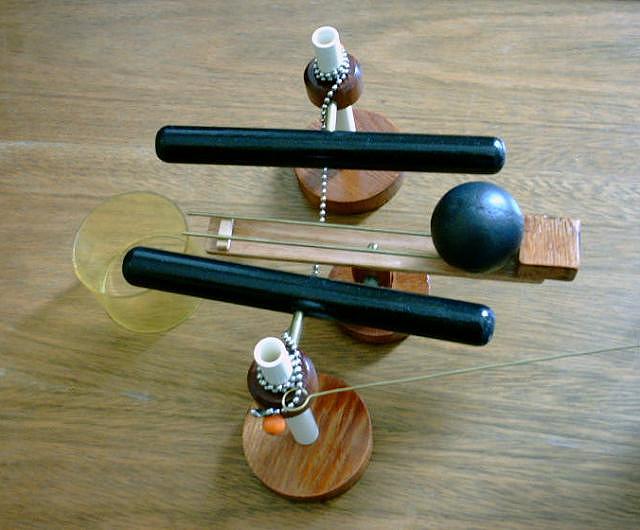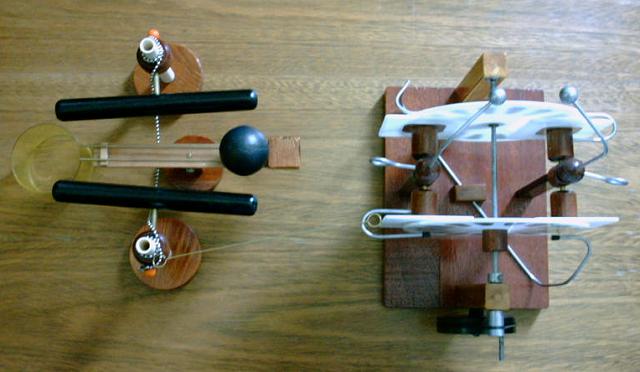

The demonstration device shown above is an "electrostatic linear motor", that I built in January 2002. It consists of ramp with rails and adjustable inclination, two adjustable "inductor blocks", and a light styrofoam ball. The ball was painted with conductive ink (china ink), and the inductors, made of wood, too. The two inductors, insulated from the ground by their PVC supports, are positioned at the sides of the ramp, being closer to it at its higher end. Both are interconnected by a suspended chain and connected to one terminal of an electrostatic machine. I used my Toepler machine for the experiment.

With the system properly adjusted, when the machine applies a high voltage to the inductors, the ball is pushed up the ramp and falls at the other end. The device is similar to something similar that can be made with a steel ball and magnets ("SMOT"), but the forces are smaller, with the ramp having low inclination and the ball being very light.
As happens with the magnetic system, ignoring corona losses, no energy is spent in the process, as no net charge is drained from the inductors. The ball, however, doesn´t gain any energy too. It hits the ground with the same total energy that it would have if dropped from its initial height. The mechanical energy to make the ball climb the ramp comes from a mix of two mechanisms: If the charge Q in the capacitance between the ball and the inductors is kept constant (low charging current), there is a reduction on the electric energy stored in the system, because the capacitance C between the inductors and the ball is increased as it climbs (energy = Q2/(2C)). If the power supply keeps the voltage at the inductors constant, the electric energy that enters the system is given by the integral of the electric power (voltage x current) entering the system while the ball moves. As the voltage V is constant, this results in energy = V x variation in Q. But the difference between the electric energies in the system with the ball at the higher point and at the lower point of the ramp is given by energy = 0.5 x V x variation in Q. Just half of the energy coming from the power supply is stored in the capacitance C. The other half being converted in mechanical energy. This energy, except for losses, is returned to the system when the ball falls.
The device also works with the inductors grounded and the ramp, insulated from the ground, connected to the power supply. Corona losses, however, are higher, because the ramp and rails have areas with small curvature radius. It is also possible to connect each inductor to one terminal of the machine, and have the ball falling with (ideally) no charge on it, but it's difficult to keep the forces balanced in this case, and the ball easily derails.

It seems possible to make the ball gain energy in the process by making it pass close enough to the inductors at the end of the ramp, draining a spark that discharges the inductors (it's actually difficult to avoid this). The ball would then drop without the braking action of the electric force, and would have gained the energy received while climbing the ramp. Of course, the discharge of the inductors and the ball by a spark consumes energy.
Created: 7 January 2002
Last update: 24 January 2002
Return to Electrostatic Machines
By: Antonio Carlos M. de Queiroz